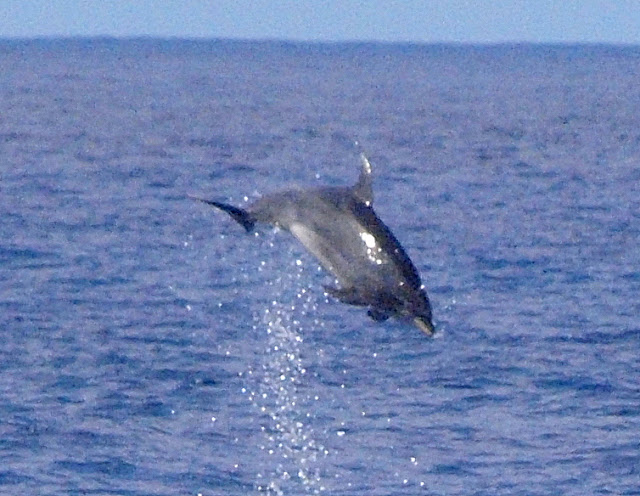The laguna Dulce was not all that great for birds, a single Marsh Harrier and a single juv. Black Tern, few ducks with several hundred Mallard but less than a dozen Gadwall, less than 20 White-headed Ducks and 6 female Red-crested Pochards. A few Barn Swallows and House Martins were feeding over the lake and I thought I caught a glimpse of a Sand Martin in the distance. Wadres limited themselves to a single Lapwing and a single Common Sandpiper, so, with nothing to keep me, it was off to Fuente de Piedra.
Once off the main road and on to that for Sierra de Yeguas before turning off for Fuente de Piedra it was easy to see the effects of the heavy rainfall, with large areas of mud on the road, some of which miraculously transferred itself to the car which is is downright filthy! Going over the top wherea one can look down on the Fuente de Piedra lake the amount of rain that had fallen was obvious. The lake has been dry since at least the end of May, it now has water covering about 90% of the surface, although not to any great depth. From the top, apart from a few distant Flamingos, 4 Grey Herons stood pondering on the meaning of life (I said 4, not 42) and a couple of Teal, there wasn't much obvious.
A stop at Cantarranas gave a female Northern Wheatear, a female Common Redstart and a single Spotted Flycatcher, plus Chiffchaffs, Serins, Greenfinches, a Blackcap and Sardinian Warblers. and a single Marsh Harrier sitting in the middle of a field and obviously equally fedup with life, it should have joined the herons! Plus a conversation with a couple of farmers surveying the damage to their lands gave me the information around 180 litres/sq.metre had fallen on the laguna. It was on the way to the information centre that I happened upon 2 Common Buzzards having a tête-à-tête on a pylon, probably exchanging gossip about how nice the weather was, although the rains must have played havoc with their food availability.
 The rest of the moring I spent around the information centre where there 2 more Spotted Flys, no less than 6 Pied Flys., a couple of Redstarts, male and female, a superb male Whinchat to go with a nearly equally handsome male Stonechat, another Blackcap and Chiffs. There must have been some 400+ Flamingos scattered across the nearer half of the laguna and certainly 500+ Shovelers. There were few waders, the most numerous being a flock of 21 Ruffs, some Avocets scattered around and a couple of Greenshanks and a single Redshank heard.
The rest of the moring I spent around the information centre where there 2 more Spotted Flys, no less than 6 Pied Flys., a couple of Redstarts, male and female, a superb male Whinchat to go with a nearly equally handsome male Stonechat, another Blackcap and Chiffs. There must have been some 400+ Flamingos scattered across the nearer half of the laguna and certainly 500+ Shovelers. There were few waders, the most numerous being a flock of 21 Ruffs, some Avocets scattered around and a couple of Greenshanks and a single Redshank heard. But there were no small plovers or other waders. For the rest, Red-rumped Swallows, Barn Swallows and House Martins and that was it.
But there were no small plovers or other waders. For the rest, Red-rumped Swallows, Barn Swallows and House Martins and that was it. The photo of the rabbit (left, just in case you mistake it for a capybara), is for those who want to sing 'Run, rabbit ...etc' , then you can show your age! And if you want to know the reason behind this ditty from the early days of World War 2, then write to me privately. Failing that, watch 'Dad's Army' because one of the singers also sang the theme to that superb BBC series.
Nearly forgot, Stephen Daly who lives over Barbate way, found a Lesser Yellowlegs yesterday, which was still there on the Barbate salinas today but taking a lot of flak from the Wood Sandpipers in the area. Lesser Yellowlegs are delightful waders, slender and very long-legged and I have seen them taking a lot of chivvying from bullying Redshanks which strongly object to their presence.
A sad end to the day when walking my aging spaniel by finding a very freshly dead juvenile Subalpine Warbler on the pavement in the centre of Torremolinos. My garden is no more than 150m in a straight line from where I found it and I see them in the garden, although mainly in the spring.









































